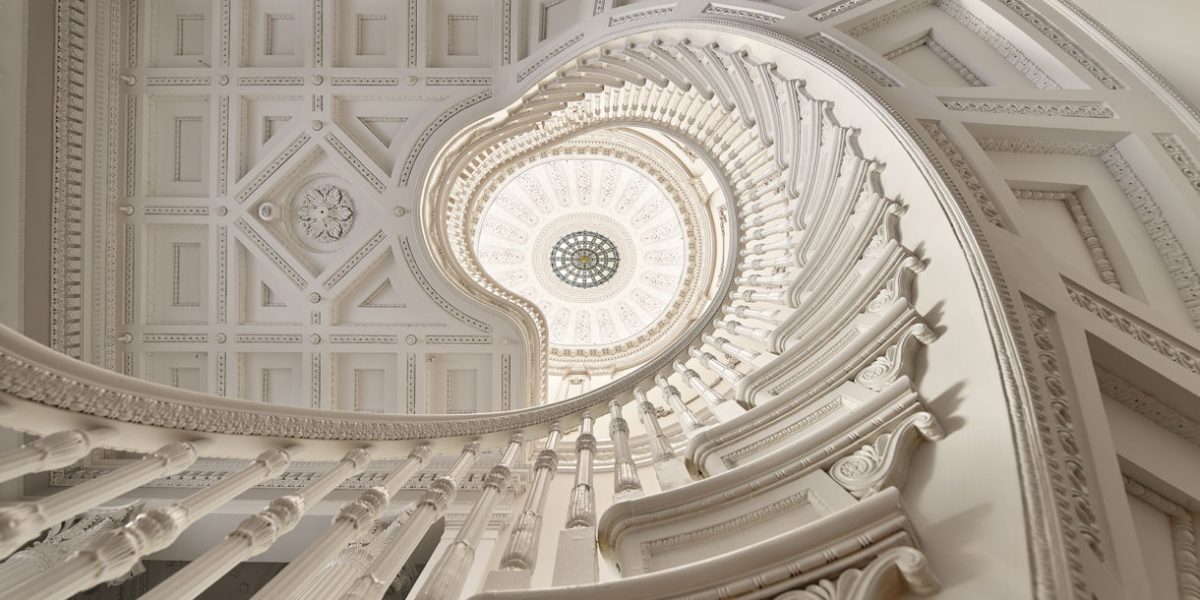Partner Content
Art museums traditionally maintain historic objects by treating them inside conservation labs, where specialists painstakingly clean and restore priceless paintings, vases, and jewelry. But how do you restore an antique that’s an entire mansion? Facing that challenge, The Walters Art Museum had to get creative.
The museum recently unveiled 1 West Mount Vernon Place, where conservators worked on-site over the past three years to bring the house back to its former glory. It’s on the southwest side of the Washington Monument, which also underwent a recent restoration.
“Historic buildings need constant cyclical attention to them in order to keep them alive, and if you don’t do major investments in them, they will fail over time,” says Lance Humphries, executive director of Mount Vernon Place Conservancy, who was involved with both projects. “You have to continually reinvest in all structures to move them forward into the future. With the monument or 1 West, as you do these reinvestments, you’re able to bring to it the latest technology and new interpretations.”
Open to the public since June, the mansion glimmers anew with the restored treasures of its original 1850 construction. Today, the Walters’ department of conservation and technical research employs a conservation scientist and eight full-time conservators who specialize in four different areas: painting, rare books and paper, objects, and conservation science. It took all hands on deck—plus additional contractors—to restore the mansion to its current evolution of part historic home and part art museum. Here are some conservation facts to know before you go.
Hot in Here
As is true for most art museums, The Walters’ environment is set at 50 percent relative humidity, and the mansion was also kept at that setting before conservators realized it was doing harm. The Walters worked with environmental specialists to find the right humidity to preserve the 170-year-old building, by adjusting it for each season. Because the paintings are sensitive to humidity changes, each has its own microenvironment at 50 percent humidity behind Plexiglass covers, while a different setting conserves the building’s architectural details.
Perfect Pottery
Many of the art works in 1 West are ceramics, representing many different cultures and time periods, and were chosen for the temporary exhibits on the first floor and second floor because they’re generally made of the most stable materials for the humidity of the house. A special exhibit curated by the conservators on the second floor shows the making, breaking, and mending of ceramics. One of two videos, created with the help of the Maryland Institute College of Art, spotlights the conservation process used for one piece on display: a 17th-century Chinese lantern broken into more than 200 pieces in the 1930s. After a Walters conservator spent countless hours cleaning it under a microscope and fastidiously putting it back together with a specially made adhesive, it’s difficult to see the cracks with the naked eye. But one of the videos in the room shows how a light placed within still glows through slivers.
Swing from the Chandelier (Or at Least Get Close Enough To)
To restore the two ornate Baccarat-style chandeliers original to the house, conservators used scaffolding, getting nearly Michelangelo-style close to the ceiling to clean the copper, tin, and zinc golden-tinted metal. Each chandelier has 36 “candles” and 141 two-tiered crystal pendants that had to be removed and cleaned. After coming across a photo of the salon in an 1864 Baltimore Sun article, researchers discovered the chandeliers were in fact gas-lit “gasoliers.” During a later renovation, the gas lines in each arm were replaced with electrical lighting.
Leather-Bound Books and Rich Mahogany
Conservators examined and treated with cosmetic sponges more than 100 19th-century books filling the mahogany library’s shelves that would have been of interest to the inhabitants of 1 West—travel books for Italy and Paris, Gulliver’s Travels, and Edgar Allan Poe volumes with gold-leaf lettering, as well as art-history books for ancient Egypt, Judea, Sardinia. To restore its luster, they also cleaned the elaborate woodwork with spot sponges—including the walls, ceilings, and protruding heads of historical and literary figures of the day.
Plaster Surprise
As the conservators were assessing restoration needs in the library, they discovered that the fabric brocade that had adorned the walls since the mansion’s first renovation in the 1890s had been covering painted plaster panels original to the house. The gray and terra-cotta-colored panels with fleur-de-lis reliefs were in rough shape. They’d sustained damage from being spackled over as well as the conduit gas and electric lines that were run straight through the walls. Although the panels look like frescos, they’re actually made of a delicate combination of chalk, pigment and glue that had to be recreated. Overall, it took two contract conservators and staff conservators about 2,500 hours to bring the room back to life.


